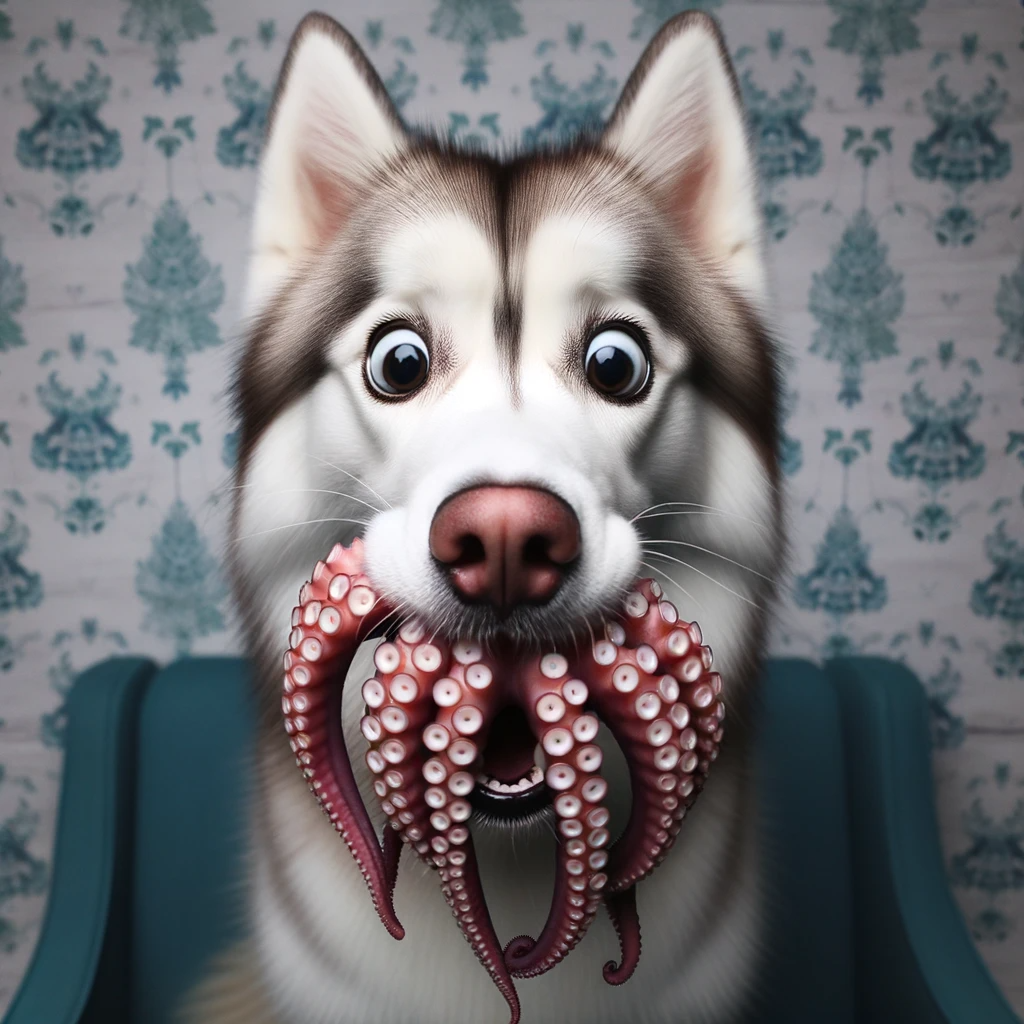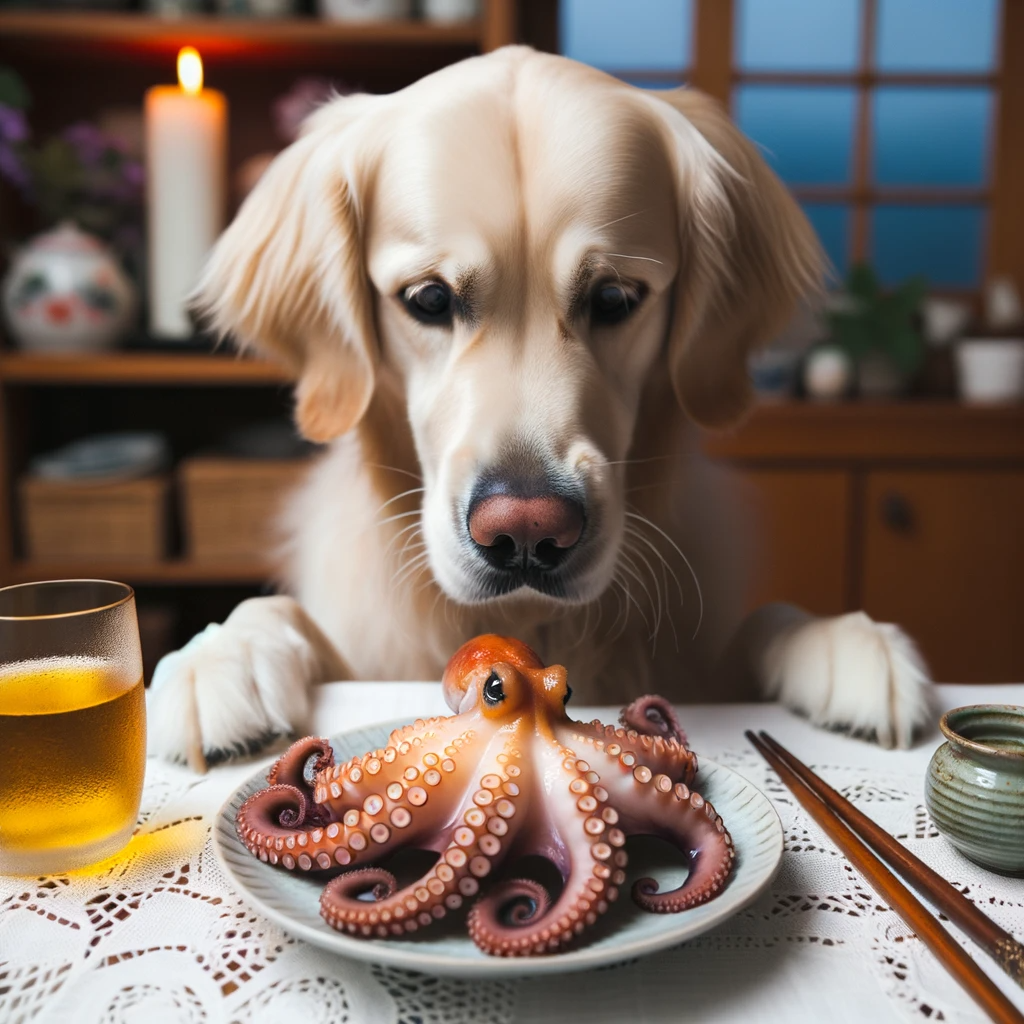Welcome to Eatdemy, your eating academy.
Our pets, especially dogs, are more than just animals in our homes. They’re family. And just like we often wonder about the best foods for ourselves and our family members, we do the same for our four-legged friends. One such interesting food item that many dog owners have thought about is the octopus. It’s not a common food item for dogs, but it’s something that some might want to explore. So, the big question is: Can dogs actually eat octopus?
Now, when we think of dog food, the usual suspects come to mind: kibble, bones, and maybe some table scraps. But as the world becomes more interconnected and our own diets become more diverse, it’s only natural to wonder if our pets might also enjoy or benefit from some of these foods. Plus, with the rise of cooking shows and food influencers, many of us are getting adventurous in our kitchens. And when we whip up something new and delicious, it’s hard to resist those pleading eyes of our pups asking for a bite.
Octopus, considered a delicacy in many cultures, is gaining popularity worldwide. Its unique texture and rich flavor make it a favorite in many seafood dishes. But beyond its taste, the octopus is packed with nutrients. And with more people trying and loving it, the thought of sharing a bit with their furry friend might pop up.

But before we dive deeper into the octopus’s world and see if it’s a suitable treat for our dogs, we need to understand what’s inside this sea creature. What does it offer in terms of nutrition? Are there any potential risks? And most importantly, how should one serve it to ensure the safety of their beloved pet?
TLDR: Can Dogs Eat Octopus? – Quick Overview
Octopus can be a tasty treat for dogs when prepared right. It offers protein and Omega-3 fatty acids, which can support overall health. However, it’s essential to cook the octopus properly and remove any hard parts like the beak to prevent choking hazards. Always introduce new foods like octopus in moderation and observe your dog for any reactions. While octopus can be a fun treat, it shouldn’t replace a balanced canine diet. Always consult with a vet if unsure.
Nutritional Breakdown of Octopus
Octopus is a sea creature that many people around the world eat. But what about our dogs? Before we decide if dogs can eat octopus, let’s first understand what nutrients are in it.
1. Protein in Octopus
Octopus is full of protein. Protein is like the building block for our body and also for dogs. It helps in making muscles strong and repairing any small damages in the body. Just like humans, dogs need protein to stay strong and healthy. When a dog eats octopus, it gets a good amount of protein.
2. Vitamins and Minerals
Octopus also has many important vitamins and minerals. These are tiny nutrients that help the body work properly. For instance, octopus has vitamin B12, which is good for the brain and nerves. It also has minerals like iron, which helps in making red blood cells. Red blood cells carry oxygen all around the body. So, iron is very important. Octopus also has selenium, which is a mineral that supports the immune system. This means it can help dogs fight off sickness.
3. Omega-3 Fatty Acids
Another great thing in octopus is Omega-3 fatty acids. This sounds complicated, but simply put, they are good fats that the body needs. These fats are good for the heart and brain. For dogs, Omega-3 can help make their fur shiny and skin healthy. It can also reduce any swelling or pain if they have joint problems.
What Does This Mean for Dogs?
So, octopus has a lot of good things in it. But does this mean dogs should eat it? Well, all these nutrients can be good for dogs. Protein helps them grow and stay strong. Vitamins and minerals keep their body working right. Omega-3 is good for their skin, fur, and joints.
But, we also need to remember that every dog is different. Just like some people might not feel good after eating certain foods, the same can happen with dogs. While octopus offers many good nutrients, it’s not something dogs usually eat. So, if a dog eats octopus for the first time, it might feel a little sick or not like it.
Things to Keep in Mind
If a dog owner decides to give octopus to their dog, there are some things to remember. First, it’s always a good idea to give a small piece and see how the dog feels. If the dog seems happy and wants more, then it might be okay. But if the dog feels sick, it’s better not to give it again.
Also, it’s important to clean the octopus well. Octopus lives in the sea, so it might have some dirt or small creatures on it. Cleaning it well will make sure the dog doesn’t eat anything bad.
Lastly, even if octopus is healthy, it shouldn’t be the only thing a dog eats. Dogs need different foods to get all the nutrients they need. Octopus can be a special treat once in a while, but not every day.
In short, octopus has many good nutrients for dogs. But, dog owners should be careful and see how their pet feels after eating it. It’s always best to talk to a vet before giving new foods to pets. They can give the best advice on what’s good for each dog.
Benefits of Octopus for Dogs
When we think about octopus, most of us probably imagine a dish at a fancy seafood restaurant or perhaps an episode of a travel show where hosts try exotic foods. But for our canine companions, could this sea creature be more than just an adventurous bite? Let’s dive into the potential benefits of feeding octopus to dogs.
1. A Protein Powerhouse
Every pet owner knows that dogs need protein. It’s essential for building strong muscles, repairing body tissues, and overall growth. Octopus, like many seafoods, is a great source of protein. Providing this lean source of protein can be beneficial, especially for dogs that are sensitive to more common protein sources like chicken or beef.
2. Omega-3 Fatty Acids: Good Fats for Good Pups
We often hear about Omega-3s when discussing human health, especially heart health. But do you know these fatty acids are also beneficial for dogs? Octopus is rich in Omega-3 fatty acids, which can:
- Support Skin and Coat Health: Omega-3s can help give your dog’s coat a shiny appearance and promote healthy skin, reducing itchy and flaky skin conditions.
- Joint Health: For older dogs or breeds prone to joint issues, Omega-3s can be beneficial in reducing inflammation, potentially providing relief from ailments like arthritis.
3. Essential Vitamins and Minerals
Apart from proteins and Omega-3s, octopus offers a range of vitamins and minerals vital for a dog’s health. For instance:
- Iron: Vital for producing red blood cells.
- Selenium: An essential mineral that supports the immune system and thyroid function.
- Vitamin B12: Supports nerve function and the formation of red blood cells.
4. Low in Fat
Octopus is naturally low in fat, making it an excellent option for dogs that need a leaner diet or are prone to gaining weight. It provides the nutritional benefits of meat without the added fats that some meats carry.
5. Potential Allergy Alternative
Some dogs develop allergies to common protein sources found in standard dog foods, like chicken, beef, or lamb. In these cases, pet owners often look for alternative protein sources. Octopus could be an alternative for dogs that have these common allergies, offering them a break from itching and other allergy symptoms.
However, while there are potential benefits, it’s essential to approach the idea of feeding octopus to dogs with a balanced perspective. While the nutritional profile is impressive, not every dog will react the same way. What works wonders for one dog might not be suitable for another. It’s always about finding the right balance tailored to your dog’s specific needs.

Potential Concerns with Feeding Octopus to Dogs
Every coin has two sides, and while octopus might seem like a nutrition-packed option for dogs, it’s essential to consider potential risks and concerns. Just as we exercise caution when introducing any new food into our diet, we must do the same for our furry friends.
1. Choking Hazards: Tentacles and Beak
Octopus has a unique anatomy. Those long, wriggly tentacles and the hard beak can present choking hazards, especially for smaller dogs. The tentacles might get lodged in a dog’s throat, causing distress or even leading to more severe complications. The beak, which is hard and sharp, is another part of the octopus that can cause problems if ingested.
Solution: If you decide to give octopus to your dog, ensure it’s adequately prepared. Remove the beak and consider chopping the tentacles into smaller, more manageable pieces.
2. Digestive Upsets
Every dog’s digestive system is different. While some might gobble down octopus and ask for seconds, others might not take to it as well. New foods can cause stomach upsets, leading to symptoms like diarrhea or vomiting.
Solution: Always introduce octopus (or any new food) gradually. Start with small amounts to see how your dog reacts. If there’s any sign of digestive distress, it might be best to avoid it in the future.
3. Allergic Reactions
Just as humans can be allergic to seafood, so can dogs. While seafood allergies in dogs are not as commonly discussed as beef or chicken allergies, they do exist. Symptoms might include itching, swelling, or digestive upsets.
Solution: Be observant. If you notice any signs of an allergic reaction after feeding octopus, consult with your vet immediately.
4. Sodium Content
Octopus, naturally found in the ocean, can have a high sodium or salt content. Too much salt is not good for dogs and can lead to increased thirst, urination, and even sodium ion poisoning in extreme cases.
Solution: If you’re preparing octopus at home, ensure it’s rinsed thoroughly. Avoid adding any extra salt during the cooking process.
5. Potential Toxins and Contaminants
Seafood, in general, can sometimes be exposed to toxins or contaminants in the ocean. While rare, there’s a possibility of octopus containing harmful substances, depending on where it’s sourced.
Solution: Ensure you’re sourcing octopus from reputable suppliers. It might also be beneficial to enquire about the octopus’s origin and any potential exposure to contaminants.
6. Pre-packaged Octopus Products
Pre-packaged or processed octopus products might contain additives, preservatives, or flavorings not suitable for dogs. These can be harmful and lead to various health issues.
Solution: If buying pre-packaged octopus, always check the label. Opt for products with minimal additives and no harmful chemicals.
Preparing Octopus for Dogs
Choosing to offer octopus to your dog is one decision, but how you serve it is equally crucial. Proper preparation can mitigate many of the risks associated with feeding octopus to dogs. Let’s explore the best practices to ensure your dog enjoys the treat safely.
1. Freshness is Key
Always opt for fresh octopus. Like all seafood, the fresher it is, the better and safer it will be for consumption. Fresh octopus will have a mild sea scent, firm flesh, and clear eyes if the head is still attached.
Solution: Buy octopus from reputable seafood markets or stores. If unsure about its freshness, ask the seller or check for a clear expiration date.
2. Cleaning the Octopus
Before cooking, it’s essential to clean the octopus thoroughly. This step ensures that any sand, grit, or other impurities are removed.
Steps for Cleaning:
- Rinse Under Cold Water: This helps remove any loose particles.
- Remove the Beak: The beak is the hard part located at the center of the tentacles. It’s crucial to remove this as it can pose a choking hazard.
- Remove the Eyes and Ink Sac: These parts are not harmful but are usually removed for culinary purposes.
3. Cooking Methods
Raw octopus can be tough and chewy, making it harder for dogs to digest. Cooking it not only softens the meat but also kills any potential pathogens.
Boiling: This is the most straightforward method. Place the cleaned octopus in a pot of boiling water for about 20-30 minutes until it becomes tender. You can test its doneness by poking it with a fork.
Grilling: If you’re feeling adventurous, grilling octopus can give it a nice flavor. However, ensure it’s boiled first to tenderize, then briefly grilled for that smoky flavor.
Steaming: Another gentle method is to steam the octopus, ensuring it’s tender but not overcooked.
Note: Regardless of the method, avoid adding seasonings, especially salt, as octopus already has a natural saltiness from the sea.
4. Serving Size and Frequency
Even if octopus is safe for your dog, moderation is essential. It should be treated as an occasional delicacy, not a regular meal.
Solution: Offer small pieces as a treat. For smaller dogs, even smaller portions are advisable. Depending on your dog’s size and dietary needs, consult your vet for serving size recommendations.
5. Storing Leftovers
If you’ve prepared more octopus than your dog can consume in one go, store the leftovers properly to ensure they remain fresh.
Solution: Place the cooked octopus in an airtight container and refrigerate. It’s best to use it within 2-3 days to ensure freshness.
6. Monitoring Your Dog
After serving octopus to your dog for the first time, it’s crucial to observe any reactions. Look for signs of digestive upset, allergies, or any other unusual behavior.
Solution: Always be on the lookout for any changes in your dog’s behavior or health after introducing a new food item. If anything seems off, consult your veterinarian.

Alternative Seafood Options for Dogs
Dogs, with their curious nature and often insatiable appetite, might have you considering various foods to add a bit of excitement to their diet. While we’ve delved deep into the world of octopus, the vast ocean offers other seafood options worth considering.
1. Fish: A Common Choice
Many dog foods and treats already include fish, making it a familiar option for most dog owners.
Benefits:
- Rich in Omega-3 Fatty Acids: Fish, especially fatty ones like salmon and mackerel, are packed with Omega-3s, which support heart health, reduce inflammation, and promote a shiny coat.
- Easily Digestible Protein: Fish offers a lean protein source that’s easy on the digestive system.
Concerns:
- Bones: Small fish bones can pose a choking hazard or cause internal injuries.
- Raw Fish: Some raw fish can carry parasites harmful to dogs.
2. Shrimp: A Delightful Treat
Shrimp can be a delicious treat for dogs when served correctly.
Benefits:
- Low in Fat and Calories: Shrimp is a lean source of protein, making it suitable for weight management.
- Vitamin B12 and Selenium: These nutrients support metabolic processes and the immune system.
Concerns:
- Shells: The hard shells can be difficult for dogs to digest and may cause choking.
- Allergies: Some dogs might be allergic to shellfish.
3. Clams and Mussels: Lesser-Known Options
Though not as common, these shellfish can be considered for dogs.
Benefits:
- Minerals Galore: Both clams and mussels are rich in essential minerals like iron, zinc, and magnesium.
- Omega-3 Fatty Acids: They also provide a good dose of these beneficial fats.
Concerns:
- Source: Ensure they are sourced from clean waters to avoid potential toxins or pollutants.
- Shells: Always remove shells before serving to prevent any injuries.
4. Squid: Similar to Octopus
Squid, a close relative of the octopus, is another potential dog treat.
Benefits:
- Protein and Selenium: Squid offers a good protein source and is rich in selenium.
- Low in Saturated Fats: This makes squid a heart-healthy option.
Concerns:
- Choking Hazards: Like octopus, certain parts of the squid can be problematic.
- Cooking: Ensure it’s properly cooked to soften the meat and kill any pathogens.
5. Crab: A Delicacy from the Deep
Crab meat can be a flavorful addition to a dog’s diet.
Benefits:
- Vitamin B12 and Phosphorus: These nutrients support nerve function and bone health.
- Omega-3 Fatty Acids: Crab meat offers these beneficial fats in good amounts.
Concerns:
- Shells and Bones: These parts can be hard and sharp, posing risks if ingested.
- Seasonings: If offering crab meat, ensure it’s free from harmful seasonings or additives.
Factors to Consider When Introducing New Foods
The world of pet nutrition is vast and ever-evolving. With an abundance of information and options available, making decisions about what to feed our furry companions can sometimes feel overwhelming. While exploring exotic foods or unique dietary items can be exciting, it’s crucial to approach these choices with care.
1. Individual Health Needs
Every dog is unique. Factors like age, breed, health history, and activity level can significantly influence dietary needs.
- Age: Puppies might have different nutritional requirements compared to senior dogs.
- Health Conditions: Dogs with specific health issues, like diabetes or kidney problems, might have strict dietary guidelines.
Solution: Regular vet check-ups can provide insights into your dog’s specific health needs. Tailor their diet accordingly.
2. Allergies and Sensitivities
Just like humans, dogs can develop allergies or sensitivities to certain foods. Symptoms might include itching, digestive issues, or respiratory problems.
Solution: Always introduce new foods in small quantities and monitor for any adverse reactions. If you suspect an allergy, consult your veterinarian.
3. Nutritional Balance
While it’s tempting to give our dogs new and tasty treats, it’s essential to ensure they receive a balanced diet.
Solution: Research the nutritional content of new foods. Ensure your dog gets a mix of proteins, healthy fats, vitamins, and minerals. Occasional treats are fine, but they shouldn’t replace a balanced meal.
4. Quality and Source of the Food
Not all foods are created equal. The quality and source of any food item can significantly impact its nutritional value and safety.
Solution: Opt for high-quality, preferably organic, sources. If considering exotic meats or seafood, ensure they come from reputable suppliers.
5. Preparation and Cooking
Certain foods might be harmful when raw or if prepared inappropriately. For instance, raw fish can carry parasites, and certain vegetables can be toxic unless cooked.
Solution: Research the best ways to prepare and serve any new food. Avoid adding spices, salts, or seasonings that might be harmful to dogs.
6. Portion Sizes
Even if a food item is safe and nutritious, overfeeding can lead to problems like obesity or digestive issues.
Solution: Be mindful of portion sizes. Treats and new foods should complement the main diet, not replace it.
7. Consultation with Experts
While there’s a wealth of information available online, nothing beats the insights of a trained professional.
Solution: Before making significant changes to your dog’s diet or introducing unusual foods, consult with a veterinarian or pet nutritionist.
8. Observing and Adapting
Dogs can’t verbally communicate how they feel about a new food or if it’s causing discomfort. Therefore, keen observation is crucial.
Solution: Monitor your dog’s behavior, energy levels, and physical signs (like coat quality) after introducing new foods. If something seems off, reconsider your choices.
Frequently Asked Questions (FAQs): Can Dogs Eat Octopus?
1. Is octopus safe for dogs to eat?
Yes, octopus is generally safe for dogs to eat in moderation, provided it’s prepared correctly. It should be cooked, with the beak and any hard parts removed to prevent choking hazards.
2. What are the nutritional benefits of octopus for dogs?
Octopus is a good source of protein, Omega-3 fatty acids, and several vitamins and minerals, such as B-vitamins and selenium, which can support overall health.
3. Can I feed my dog raw octopus?
It’s not recommended. Raw octopus can carry bacteria or parasites that can harm your dog. Always cook octopus before offering it to your pet.
4. How often can I give my dog octopus?
Octopus should be an occasional treat and not a regular part of your dog’s diet. Offering it once a week or less is a safe approach.
5. Can puppies eat octopus?
Puppies can try octopus, but it’s essential to offer it in smaller, more manageable portions and ensure it’s well-cooked. As always, monitor for any allergic or adverse reactions.
6. Are there any risks associated with feeding octopus to dogs?
Potential risks include choking hazards from the tentacles and beak, allergic reactions, and digestive upsets. Always introduce new foods gradually and observe your dog for any adverse reactions.
7. Can I give my dog other seafood items as well?
Many seafood items, like fish and shrimp, can be safe for dogs when prepared correctly. However, always research and consult with a vet before introducing new seafood to your dog’s diet.
8. My dog ate a whole octopus, including the beak. What should I do?
Monitor your dog closely for any signs of distress or choking. If you’re concerned or notice any unusual behavior, contact your veterinarian immediately.
9. Can I give my dog octopus flavored treats or toys?
Octopus-flavored treats or toys might be safe, but always check the ingredients and ensure they don’t contain any harmful additives or chemicals. When in doubt, consult with a vet.
10. Where can I buy octopus for my dog?
Fresh octopus can be purchased at seafood markets or specialty grocery stores. Ensure it’s fresh and sourced from reputable suppliers.






[…] is safe for dogs isn’t as straightforward as it might seem. While chicken, in general, is a good source of protein for dogs, the way rotisserie chicken is prepared may pose some risks. It’s seasoned with a variety of […]
[…] oil is another beneficial supplement for dogs, providing essential fatty acids like Omega-3 and […]